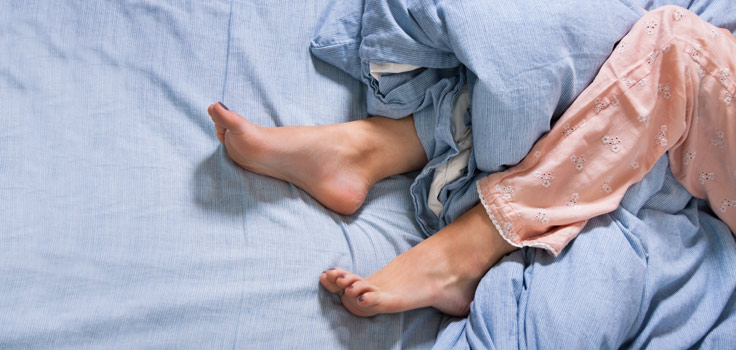Restless leg syndrome (RLS) is a condition that affects the legs. Since the symptoms are typically worse at night, when the patient is trying to sleep, it can also interfere with sleep.
What are the Symptoms?
A person with restless leg syndrome feels unpleasant sensations in their legs that compel them to move their legs in order to relieve them. The sensations vary from patient to patient. Many patients have trouble describing the sensations, but others have characterized them as itching, throbbing, aching, pulling, creeping or crawling. The sensations may be merely uncomfortable, or they may be painful.
In some cases, the sensations affect just one side of the body, but it more commonly affects both sides. In some patients, the arms are also affected. In rare cases, the patient may experience the sensations on their head or chest.
Since moving the legs or other affected body part relieves the sensations, patients will move the affected part to get relief. They may toss or turn in bed, or they may get up and pace. The symptoms are typically worse at night.
Restless leg syndrome varies in severity. It is considered moderate if the patient has one or two episodes per week that disrupt their sleep. In severe cases, the patient has three or more episodes per week that disrupt their sleep.
What Causes RLS?
In most cases, doctors don’t know what causes restless leg syndrome, and they, therefore, call it primary RLS. Researchers have found that RLS does have a genetic component, for it can run in families. Certain mutant genes have been linked to the condition.
Various medical conditions and drugs can cause restless leg syndrome or make it worse. For example, caffeine, alcohol and nicotine can cause RLS. Various medicines can make the condition worse. Examples of such medications include antidepressants, anti-nausea drugs, antipsychotic drugs and some allergy and cold medicines that contain certain antihistamines.
Pregnancy can cause restless leg syndrome, especially during the third trimester. In most cases, the symptoms fade within a month of giving birth. End-stage renal disease and hemodialysis can both cause RLS. Iron deficiency, diabetes, Parkinson’s disease and neuropathy can cause the condition as well.
Who Gets Restless Leg Syndrome?
RLS is a common condition that may affect about 10 percent of the people in the United States. While it is more common in women, it can affect both sexes. Although it can occur at any age, people who are middle-aged or older tend to develop the most severe symptoms.How is RLS Treated?
There is currently no cure for RLS, but our doctor at Smith Vein Institute can prescribe a variety of treatments to help control the symptoms. We have offices in Concord Township and Middlefield. Contact us today to schedule a consultation to learn more about your treatment options.



